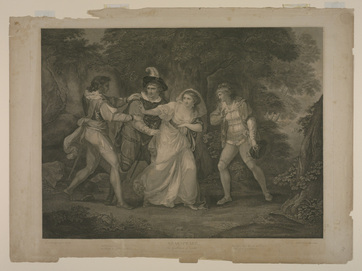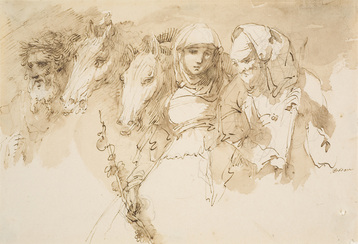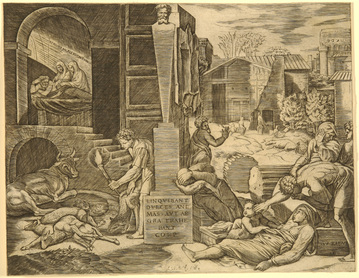
Recently, our class visited the Spencer Museum of Art on the University of Kansas campus to view artwork that would help the class visualize the characters and setting of I promessi sposi. Although Manzoni describes each character's dress and appearance in depth and guides the reader to envision the abhorrence of the famine and plague of Milan, it is useful to examine artwork from the time period in which Manzoni was writing and the time period in which I promessi sposi takes place in order to see another artist's point of view. There are four pieces in particular that I would like to discuss: head of a monk (artist unknown), Two gentlemen of Verona, Act V Scene III by Angelica Kauffmann, an untitled work by Giuseppe Bernardino Bison, and The Plague of Phrygia by Raphael.

The first piece of art, head of a monk, is a chalk sketch done by an unknown artist from a Roman school. The sketch was done during the time period in which I promessi sposi takes place. This work is an excellent visualization of the character Father Cristoforo. In I promessi sposi, Father Cristoforo is friar of the Capuchin Order, and this sketch helps the reader to vision the hairstyle and beard of a friar. Friars practiced tonsure, the removal of their hair, to show that they were slaves to God. In this sketch, the monk is deep in thought, shying away from the viewer. This piece of art helps the reader to imagine the stress Father Cristoforo's face when he is trying to decide how to help Lucia and Renzo, or perhaps how to confront Don Rodrigo.

The second piece of art, Two Gentlemen of Verona, Act V Scene III, is an engraving done by Lewis Schiavonetti. The original artist Angelica Kauffmann completed the work sometime between the late 1700s and early 1800s. The piece depicts a scene from Shakespeare's 17th-century comedy Two Gentlemen of Verona. The scene is being reinterpreted during the time of the Schiavonetti. This piece was completed during the time that Manzoni was writing I promessi sposi, another example of an artist reinterpreting the work of previous artists. This piece also helps the reader to speculate the dress and demeanor of the characters of I promessi sposi. It also provides an example of female-male interaction. In contrast to this work, the character of I promessi sposi show little affection, even the betrothed Lucia and Renzo.

The third piece of art is an untitled work by Giuseppe Bernardino Bison. This piece was completed sometime during the late 1700s and mid 1800s. The sketch was done with pencil, pen, ink, and wash and depicts a women with a grapevine, a man with a laurel wreath, and another woman on horses. Since this piece was also done during the time that Manzoni was writing I promessi sposi, it is inevitable that the viewer can utilize this piece to imagine the dress and demeanor of the characters. In my opinion, this image can be used to envision the scene in which Lucia and Agnese flee from Lecco. The women wear hooded tunics to hide their faces and Lucia holds a grapevine. In the Old Testament, the grapevine is a sign of the chosen people. Lucia represents the truth and the light in I promessi sposi. Her presence helps the Unnamed to abandon his life of sin for one of morality. Lucia's virtuous nature and devotion to God are matched to the woman in this piece.

The last piece of art, The Plague of Phrygia, is an engraving done by Marcantonio Raimondi sometime between the late 1400s and early 1500s. The original artist Raphael recreated the plague that devastated the ancient kingdom of Phrygia. This piece can be utilized for the reader of I promessi sposi to visualize the plague that struck Milan in 1629. In this piece, there is a clear division between private and public, or rich and poor. However, in I promessi sposi, Manzoni describes how the plague made class division null. The plague of Milan forced everyone to dress the same, eat the same, and die the same. In this piece, there is also a statue in the middle, which divides the public from the private. The statue represents either political or religious institutions that stands above everyone else and remains untouched by the plague. This is similar to the plague of Milan in which the highest political and religious figures remained unaffected by the tragedy.
 RSS Feed
RSS Feed